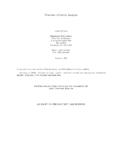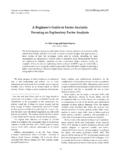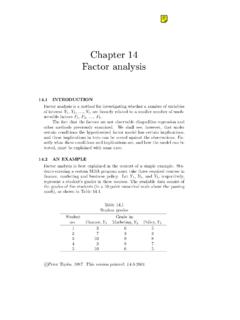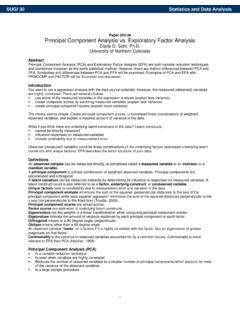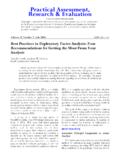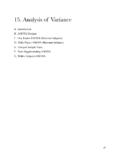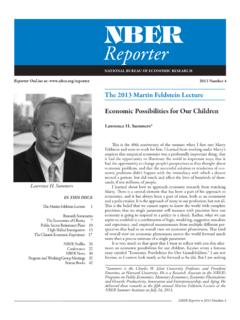Transcription of 200-31: Exploratory or Confirmatory Factor Analysis?
1 1 Paper 200-31 Exploratory or Confirmatory Factor analysis ? Diana D. Suhr, University of Northern Colorado Abstract Exploratory Factor analysis (EFA) could be described as orderly simplification of interrelated measures. EFA, traditionally, has been used to explore the possible underlying Factor structure of a set of observed variables without imposing a preconceived structure on the outcome (Child, 1990). By performing EFA, the underlying Factor structure is identified. Confirmatory Factor analysis (CFA) is a statistical technique used to verify the Factor structure of a set of observed variables. CFA allows the researcher to test the hypothesis that a relationship between observed variables and their underlying latent constructs exists.
2 The researcher uses knowledge of the theory, empirical research, or both, postulates the relationship pattern a priori and then tests the hypothesis statistically. The process of data analysis with EFA and CFA will be explained. Examples with Factor and CALIS procedures will illustrate EFA and CFA statistical techniques. Introduction CFA and EFA are powerful statistical techniques. An example of CFA and EFA could occur with the development of measurement instruments, a satisfaction scale, attitudes toward health, customer service questionnaire. A blueprint is developed, questions written, a scale determined, the instrument pilot tested, data collected, and CFA completed. The blueprint identifies the Factor structure or what we think it is.
3 However, some questions may not measure what we thought they should. If the Factor structure is not confirmed, EFA is the next step. EFA helps us determine what the Factor structure looks like according to how participant responses. Exploratory Factor analysis is essential to determine underlying constructs for a set of measured variables. Confirmatory Factor analysis CFA allows the researcher to test the hypothesis that a relationship between the observed variables and their underlying latent construct(s) exists. The researcher uses knowledge of the theory, empirical research, or both, postulates the relationship pattern a priori and then tests the hypothesis statistically. The use of CFA could be impacted by the research hypothesis being testing the requirement of sufficient sample size ( , 5-20 cases per parameter estimate) measurement instruments multivariate normality parameter identification outliers missing data interpretation of model fit indices (Schumacker & Lomax, 1996).
4 A suggested approach to CFA proceeds through the following process: review the relevant theory and research literature to support model specification specify a model ( , diagram, equations) determine model identification ( , if unique values can be found for parameter estimation; the number of degrees of freedom, df, for model testing is positive) collect data conduct preliminary descriptive statistical analysis ( , scaling, missing data, collinearity issues, outlier detection) estimate parameters in the model assess model fit present and interpret the results. Statistics Traditional statistical methods normally utilize one statistical test to determine the significance of the analysis . However, Structural Equation Modeling (SEM), CFA specifically, relies on several statistical tests to determine the adequacy of model fit to the data.
5 The chi-square test indicates the amount of difference between expected and observed covariance matrices. A chi-square value close to zero indicates little difference between the expected and observed covariance matrices. In addition, the probability level must be greater than when chi-square is close to zero. Statistics and Data AnalysisSUGI31 2 The Comparative Fit Index (CFI) is equal to the discrepancy function adjusted for sample size. CFI ranges from 0 to 1 with a larger value indicating better model fit. Acceptable model fit is indicated by a CFI value of or greater (Hu & Bentler, 1999). Root Mean Square Error of Approximation (RMSEA) is related to residual in the model. RMSEA values range from 0 to 1 with a smaller RMSEA value indicating better model fit.
6 Acceptable model fit is indicated by an RMSEA value of or less (Hu & Bentler, 1999). If model fit is acceptable, the parameter estimates are examined. The ratio of each parameter estimate to its standard error is distributed as a z statistic and is significant at the level if its value exceeds and at the level it its value exceeds (Hoyle, 1995). Unstandardized parameter estimates retain scaling information of variables and can only be interpreted with reference to the scales of the variables. Standardized parameter estimates are transformations of unstandardized estimates that remove scaling and can be used for informal comparisons of parameters throughout the model. Standardized estimates correspond to effect-size estimates.
7 In CFA, if unacceptable model fit is found, an EFA can be performed. PROC CALIS The PROC CALIS procedure (Covariance analysis of Linear Structural Equations) estimates parameters and tests the appropriateness of structural equation models using covariance structural analysis . Although PROC CALIS was designed to specify linear relations, structural equation modeling (SEM) techniques have the flexibility to test nonlinear trends. CFA is a special case of SEM. PROC CALIS and options for CFA DATA = specifies dataset to be analyzed COV covariance matrix CORR correlation matrix Exploratory Factor analysis Psychologists searching for a neat and tidy description of human intellectual abilities lead to the development of Factor analytic methods.
8 Galton, a scientist during the 19th and 20th centuries, laid the foundations for Factor analytic methods by developing quantitative methods to determine the interdependence between 2 variables. Karl Pearson was the first to explicitly define Factor analysis . In 1902, Macdonnell was the first to publish an application of Factor analysis , a comparison of physical characteristics between 3000 criminals and 1000 Cambridge undergraduates. Factor analysis could be described as orderly simplification of interrelated measures. Traditionally Factor analysis has been used to explore the possible underlying structure of a set of interrelated variables without imposing any preconceived structure on the outcome (Child, 1990).
9 By performing Exploratory Factor analysis (EFA), the number of constructs and the underlying Factor structure are identified. EFA is a variable reduction technique which identifies the number of latent constructs and the underlying Factor structure of a set of variables hypothesizes an underlying construct, a variable not measured directly estimates factors which influence responses on observed variables allows you to describe and identify the number of latent constructs ( factors ) includes unique factors , error due to unreliability in measurement traditionally has been used to explore the possible underlying Factor structure of a set of measured variables without imposing any preconceived structure on the outcome (Child, 1990).
10 Goals of Factor analysis are 1) to help an investigator determine the number of latent constructs underlying a set of items (variables) 2) to provide a means of explaining variation among variables (items) using a few newly created variables ( factors ), , condensing information 3) to define the content or meaning of factors , , latent constructs Assumptions underlying EFA are Interval or ratio level of measurement Random sampling Relationship between observed variables is linear A normal distribution (each observed variable) A bivariate normal distribution (each pair of observed variables) Multivariate normality Statistics and Data AnalysisSUGI31 3 Limitations of EFA are The correlations, the basis of Factor analysis , describe relationships.










